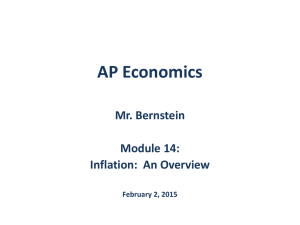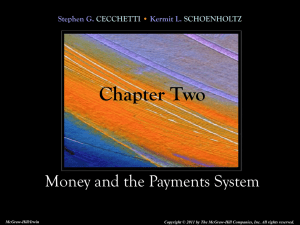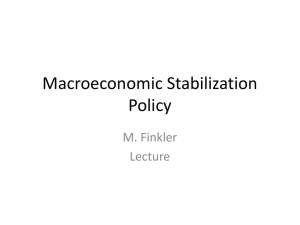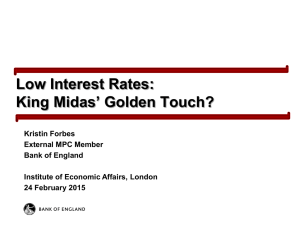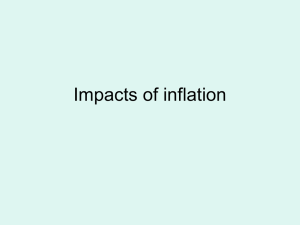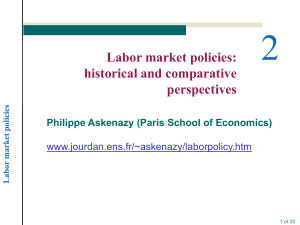slides from my recent discussion in New Zealand
advertisement
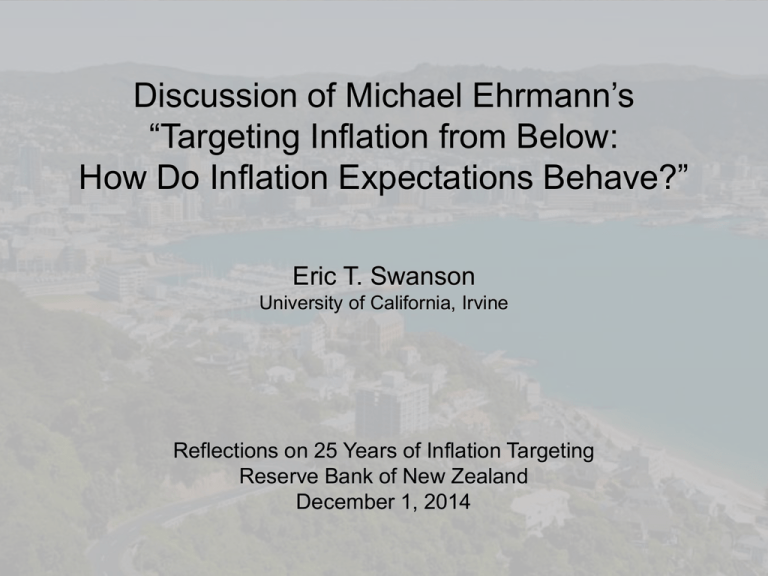
Discussion of Michael Ehrmann’s “Targeting Inflation from Below: How Do Inflation Expectations Behave?” Eric T. Swanson University of California, Irvine Reflections on 25 Years of Inflation Targeting Reserve Bank of New Zealand December 1, 2014 Forward Nominal Interest Rates: UK vs. US Forward 1-year Nominal Interest Rate, from 9 to 10 Years Ahead 10 United Kingdom United States 9 percent 8 7 6 5 4 3 1992 1993 1994 1995 1996 source: Gurkaynak, Levin, and Swanson (2010 JEEA) 1997 1998 1999 2000 2001 2002 2003 2004 2005 Great Data: 3,000 Forecast Observations Regress Forecast Dispersion on IT Indicator But standard errors for some coefficients look low. t-Statistics of 10, 20, and 40 Are Too High Comment 1: Correct for Residual Autocorrelation Use a panel Cochrane-Orcutt procedure: Estimate serial correlation: 𝜀𝑐,𝑡 = 𝜌𝑐 𝜀𝑐,𝑡−1 + ν𝑡 Then use estimated 𝜌𝑐 to transform data: Ω𝑐,𝑡 − 𝜌𝑐 Ω𝑐,𝑡−1 = 1 − 𝜌𝑐 𝛼𝑐 + 1 − 𝜌𝑐 𝛼𝑚 + 𝛾1 𝐸𝑐,𝑡 𝜋𝑐,𝑡+ℎ1 − 𝜌𝑐 𝐸𝑐,𝑡−1 𝜋𝑐,𝑡+ℎ1−1 + 𝛾2 𝐼𝑇𝑐,𝑡 − 𝜌𝑐 𝐼𝑇𝑐,𝑡−1 + 𝜈𝑡 Coefficient estimates shouldn’t change much, and standard errors will be correct (but larger). Comment 1: Correct for Residual Autocorrelation But with larger standard errors, some estimates will no longer be statistically significant: Side Comment: Think about Month Fixed Effects For forcast dispersion, month fixed effects are appropriate: e.g., in November 2014, forecasters should largely agree about 2014 inflation; in January 2014, not so much. But for h-year-ahead forecasts, month effects make little sense: e.g., no reason to think the average forecast of inflation in 2019 should be higher or lower in November than in January. Downward Time Trends Forecast dispersion may have downward trend over time: • Greater central bank credibility • Greater central bank transparency – U.S. Fed is an example (Swanson, 2006 JMCB) • Private sector learning about monetary policy • Better private sector forecasting technology • Great Moderation Inflation Targeting observations occur later in the sample Hard to disentangle effects of IT from these other factors Most convincing way: some kind of control variable GDP as a Potential Control Variable GDP seems like a potential control variable: • effects of IT on GDP volatility go in both directions • net effect is probably smaller than effect of IT on inflation But Michael’s results are 3X stronger for GDP than for inflation Comment 2: Try to Find a Control Variable Is there a control variable that makes the case that estimated effects are due to IT? GDP is one such potential control variable. But it suggests that trends in other factors are more important than IT. (Hard to argue that the effects of IT on GDP should be larger than the effects of IT on inflation.) Michael’s empirical results would be strengthened a lot if there was a good control variable. Central Bank Responsiveness to Inflation Paper asserts that IT central banks need to respond less to inflation: • “if the central bank threatens to be more aggressive on inflation, it will have to move rates by less in equilibrium.” (p. 3) • “with inflation expectations anchored at target, policy rates need to react less to changes in inflation.” (p. 22) Theoretically, this assertion is suspect: 𝑟𝑡 = 𝑖𝑡 − 𝐸𝑡 𝜋𝑡+1 If a shock causes 𝐸𝑡 𝜋𝑡+1 to increase when policymakers want lower 𝑟𝑡 , then 𝑖𝑡 under IT needs to respond more, not less • e.g., some supply shocks – “increases in oil prices today are more likely to promote consideration of increased policy ease” (Bernanke, 2003 speech) Central Bank Responsiveness to Inflation Empirically, the assertion is also suspect: Comment 3: Central Bank Responsiveness The idea that IT central banks need to respond less to inflation seems to come from “strict inflation targeting” intuition. But this intuition may not hold for flexible inflation targeters, which is the relevant case in practice: “For quite a few years now, however, strict inflation targeting has been without significant practical relevance. In particular, I am not aware of any real-world central bank (the language of its mandate notwithstanding) that does not treat the stabilization of employment and output as an important policy objective.” (Bernanke, 2003 speech) The paper should soften (or at least justify better) its claims about monetary policy responsiveness to inflation. A Few Side Comments Definition of IT is often subjective: • UK adopted IT in 1992, but BoE not independent until 1997-8 • Not clear whether or when US should be classified as IT Adoption of IT is endogenous: • Creates sample selection problem • If high-inflation countries adopt IT, and there is mean reversion, then effects of IT will be overestimated (Ball and Sheridan, 2005) Today, IT is arguably just a method of communicating optimal monetary policy. Difference between IT and non-IT central banks is arguably just one of communication, not substance. Summary Main Comments: 1. Correct standard errors for residual autocorrelation. 2. Try to find a control variable to help distinguish effects of IT from other factors that improved over time. 3. Either soften or justify claim that IT implies less central bank responsiveness to inflation. Minor Comments: • Think about and clean up month fixed effects • The IT classification is subjective: check for robustness • Discuss potential problems of IT endogeneity, mean reversion • Is the IT vs. non-IT distinction meaningful? Or is it just a difference in transparency and communication?



